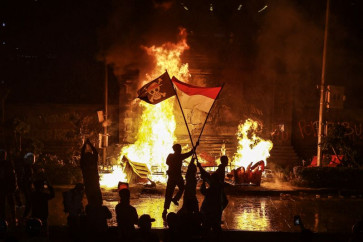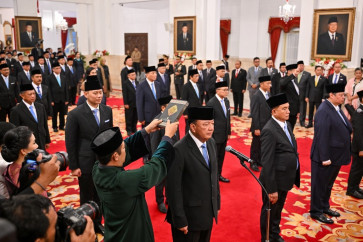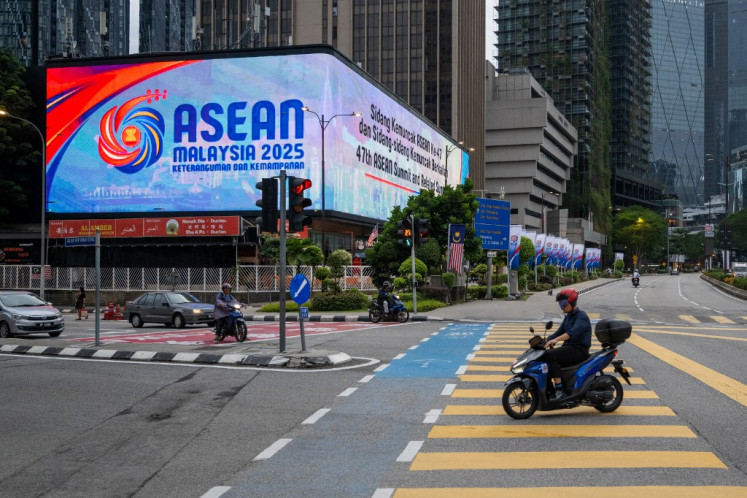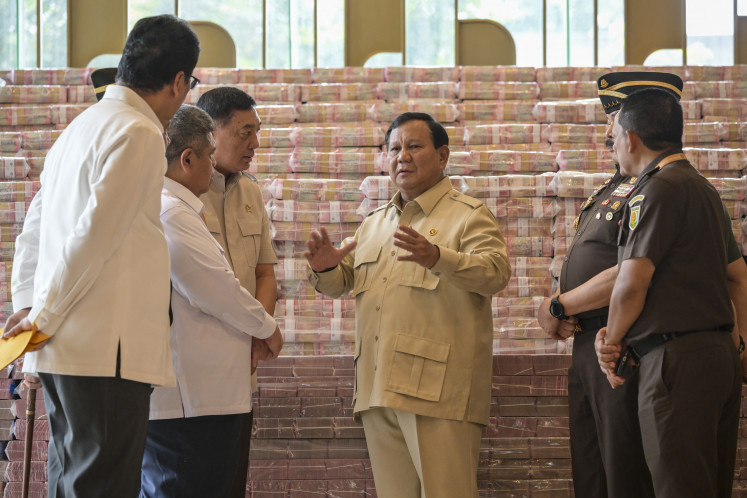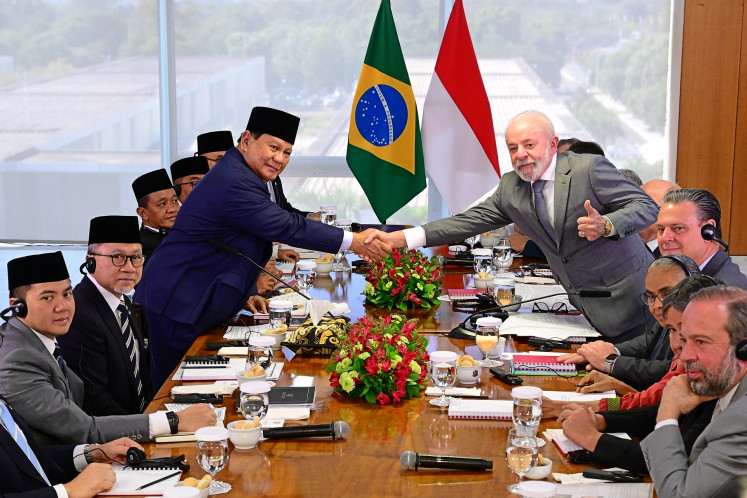Popular Reads
Top Results
Can't find what you're looking for?
View all search resultsPopular Reads
Top Results
Can't find what you're looking for?
View all search resultsVientiane: Asia’s most laid-back capital city
Twenty-three years ago, as a young 20-something backpacker, I remember traveling through Thailand, reaching the Thai border town of Nong Khai on the banks of the Mekong, and gazing across to Laos on the opposite side of the wide, fast-flowing river
Change text size
Gift Premium Articles
to Anyone
Twenty-three years ago, as a young 20-something backpacker, I remember traveling through Thailand, reaching the Thai border town of Nong Khai on the banks of the Mekong, and gazing across to Laos on the opposite side of the wide, fast-flowing river.
I wondered what it would be like to visit the Lao capital just a few kilometers up the river.
In those days, Laos — or more correctly the Lao People’s Democratic Republic — had an exotic and forbidden air to it, only 14 years before the communist Pathet Lao had taken power, shortly after the fall of Saigon to the North Vietnamese and Phnom Penh to the Khmer Rouge.
And of course, there was still no “Friendship Bridge” across the Mekong linking the two countries at the time, but instead only small motorized boats flying tiny Pathet Lao flags, fluttering in the wind, were plying the river crossing.
In those days, only locals were allowed to cross. Fast-forward to 2012 and, having never visited the country before, I had my first chance to make the trip by air from Kuala Lumpur to Laos, making Vientiane my first port-of-call.
Incidentally, the name Vientiane is actually a French transliteration of the Lao name for “city of sandalwood”, pronounced wiang chan. Lao people in frequent contact with foreigners seem to be happy to use the French version, although in their own language it remains wiang chan.
The Patuxai, Lao’s “Arc de Triomphe”, built in the 1960s with concrete meant for a new airport runway.Things have changed a great deal in the 23 years since I gazed across the river, with the collapse of the Soviet Union and the end of the Cold War in 1990, the economic rise of China and Lao PDR’s membership of the Association of Southeast Asian Nations (ASEAN) in 1997.
Today, Vientiane is booming, tourists flock to the city and the country as a whole. However, Vientiane still retains much of its original small-town charm, and still distinctly lacks the hustle and bustle of most other Asian capitals — at least for now.
It is one of the few remaining relatively traffic-free Asian cities, where touring on a bicycle is probably the best way of getting around.
If there were a title for the most relaxed and laid-back capital in Asia, Vientiane would surely win the prize. That in itself makes the city — which is really little more than a town, with a population of under 300,000 — an interesting place to explore and soak up the atmosphere for a few days.
Although Vientiane was first settled way back in the ninth century AD, it hasn’t always been the capital of Laos. It’s only since the mid-16th century, when the king moved the seat of government from Luang Prabang, further north, to avoid the invading Burmese armies that Vientiane’s status and success grew.
Despite the move of the capital, Vientiane was to suffer much of the same fate as the rest of the country, often prey to more powerful neighbours, routinely ransacked and flattened to the ground.
Buddha images in the cloisters surrounding Vientiane’s oldest temple, Wat Si Sakit.
The most recent destruction occurred in 1828, when the Siamese (the Thais) invaded the city, sparing only the oldest Buddhist temple, Wat Si Sakit. It was only with the arrival of the French colonisers toward the end of the 19th century that serious efforts where made to rebuild the city.
During the conflicts of the 1960s and early 1970s, with the growing involvement of the United States in trying to hold back the advancing tide of communism (the so-called Domino Theory), Vientiane became a city where almost anything went, easy US dollars flowed in, bars and nightclubs were filled with Cold War spies and newspaper correspondents.
Following the takeover by the communist Pathet Lao in 1975, there was a general crackdown on western decadence and oriental Buddhism alike.
But after half-hearted and largely unsuccessful attempts at agricultural collectivization based on communist ideology, the Lao PDR decided to follow a more flexible free-market Chinese (Deng Xio Ping) model of development, and since then life in the capital has once again started to flourish.
While not over-endowed with magnificent city sights — thanks largely to its warlike neighbours — there are a handful of places that visitors to Vientiane should try to see if they have the time.
Probably the most important is the city’s oldest surviving Buddhist temple, Wat Si Sakit, completed in 1824, and restored in the 19th century by the French. The interior of the sim (the uposatha; ordination hall) contains thousands of small recesses in the walls that house miniature silver images of Buddha.
A typical Lao food stall, with Mekong river fish, noodles and vegetables. Surrounding the sim is an enclosing cloister containing rows of serene Buddha images made of wood and dressed in colourful saffron sashes.
Another temple of significance is the national monument of Pha That Luang, which is a symbol both of the Buddhist religion and Lao sovereignty. Built on the site of a 13th century Khmer temple about 4 kilometers northeast of the city center, its construction was ordered by King Setthathirat upon moving the capital from Luang Prabang in the mid-16th century.
However, the monument was subsequently badly damaged by Burmese and Siamese invaders, later abandoned, and finally restored, albeit rather badly, by the French colonial administration in 1900. It is said that in the third century BC Buddhist missionaries from India built a stupa (mound-like structure) here to enclose a piece of the Buddha’s breastbone, although excavations have so far found no trace of it.
The third monument of note is the Patuxai, an arch that some people find rather reminiscent of the Arc de Triomphe in Paris. Constructed rather more recently in the 1960s, Patuxai was supposedly built with US concrete intended for the construction of a new airport runway. A shadow of the French original, nonetheless it does have a stairway up to the top level, giving great views over Vientiane.
While other interesting sights include: Haw Pha Kaew next to the Presidential Palace, which houses the Emerald Buddha, one of the two most scared images of Buddha in Laos; Wat Simuang, which is the most popular and active temple; the Lao National Museum; and the “Friendship Bridge” spanning the Mekong to Thailand, the truth is that the real pleasure of Vientiane comes from experiencing firsthand its laid back lifestyle, with its street level food, its wine, its Lao massage parlours and getting up close and personal with its nightlife.
In many ways, Vientiane offers the best of both worlds, as far as being an Asian capital city goes, there are few traffic jams so there is the joy of just kicking back and enjoying life in its markets, food-stalls, cafés, good restaurants and slightly seedy bars.
The best you could do is to start your first morning in Vientiane by reading a copy of the English-language Vientiane Times in a café, such as Le Banneton or the Scandinavian Bakery both famous for their Lao coffee, excellent breakfasts and delicious (and huge) baguette sandwiches.
c: A gift from Australia, the Friendship Bridge across the Mekong, completed in 1994, linking Laos to Thailand.
After taking in a few of the local sites, head back to the city center for a traditional Lao cuisine lunch at the Khambang Lao Food Restaurant. Later on, at the end of a hard day’s site-seeing, have a refreshing cocktail on the banks of the Mekong at the classy and exotically wooden Spirit House. This is one of the most chic places in which to hang out in Vientiane and gaze at the mighty Mekong flowing past on its way down from its source in Tibet. There’s a happy hour for cocktails until 8 p.m., too.
After cocktails, splash out on an haute cuisine French dinner in one of Vientiane’s premier restaurants, such as L’adresse de Tinay, above the New Lao Paris Hotel. Tinay, the Lao chef, developed his art in France over 16 years, before returning to Laos. Here you will feel at home if you’re a European like me with cravings for such French delicacies as confit de canard (duck confit) or a traditional Toulouse cassoulet (pork and white bean casserole). Bon appetite
Then, of course, there is the nightlife. Whilst Vientiane may not be quite the same den of iniquity that it once was in the American era and when Paul Theroux was last here in the mid-1970s — brothels are now prohibited. Beerlao has overwhelming replaced opium and most bars tend to close at 11:30 p.m. at the latest — but Vientiane still has plenty of evening hangouts and nightclubs.
After dinner, an excellent early evening place to head out to, to catch the setting sun if you’re not too late, is the rooftop bar in the four-story Bor Pennyang, great views across the Mekong combined with cheap Beerlao, hardy Vientiane expats, and a sprinkling of local Lao bargirls. Life could be a great deal worse.
After a few glasses of BeerLao in Bor Pennyang, head out to one of the half dozen or more nightclubs in town, where they say they are supposed to close at midnight, but I found myself getting on down until the early hours of the morning. But don’t tell the Lao authorities. I’d better not mention any names — better I leave it all to your sense of discovery, which is what Vientiane is all about.
Last but not least, if time permits don’t leave Vientiane without trying out a self-indulgent massage.
Traditional Lao massages can feel a little like visiting an osteopath, so the best option is probably to opt for a herbal sauna followed by a Swedish oil massage. One of the best places in town is the Papaya Spa, located in an old French villa to the west of the town center. When I rocked up on my rented motorbike I was the only customer and had the place to myself.
— Photos by Peter Milne






